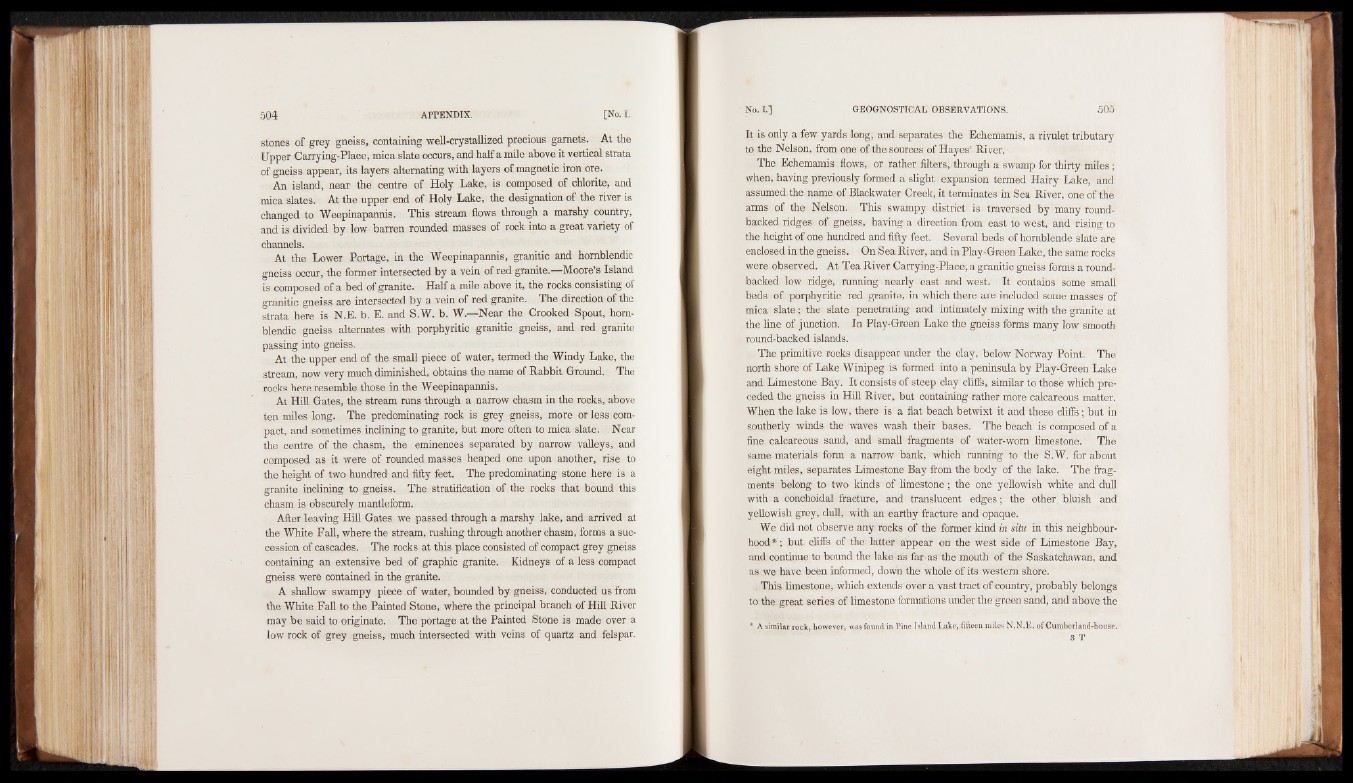
stones of grey gneiss, containing well-crystallized precious garnets. At the
Upper Carrying-Place, mica slate occurs, and half a mile above it vertical strata
of gneiss appear, its layers alternating with layers of magnetic iron ore.
An island, near the centre of Holy Lake, is composed of chlorite, and
mica slates. At the upper end of Holy Lake, the designation of the river is
changed to Weepinapannis. This stream flows through a marshy country,
and is divided by low barren rounded masses of rock into a great variety of
chaAntn etlhse. Lower Portage, in the Weepinapannis, granitic and hornblendic
gneiss occur, the former intersected by a vein of red granite.—Moore’s Island
is composed of a bed of granite. Half a mile above it, the rocks consisting of
granitic gneiss are intersected by a vein of red granite. The direction of the
strata here is N.E. b. E. and S.W. b. W.—Near the Crooked Spout, hom-
blendic gneiss alternates with porphyritic granitic gneiss, and red granite
passing into gneiss.
At the upper end of the small piece of water, termed the Windy Lake, the
stream, now very much diminished, obtains the name of Rabbit Ground. The
rocks here resemble those in the Weepinapannis.
At Hill Gates, the stream runs through a narrow chasm in the rocks, above
ten miles long. The predominating rock is grey gneiss, more or less compact,
and sometimes inclining to granite, but more often to mica slate. Near
the centre of the chasm, the eminences separated by narrow valleys, and
composed as it were of rounded masses heaped one upon another, rise to
the height of two hundred and fifty feet. The predominating stone here is a
granite inclining to gneiss. The stratification of the rocks that bound this
chasm is obscurely mantleform.
After leaving Hill Gates we passed through a marshy lake, and arrived at
the White Fall, where the stream, rushing through another chasm, forms a succession
of cascades. The rocks at this place consisted of compact grey gneiss
containing an extensive bed of graphic granite. Kidneys of a less compact
gneiss were contained in the granite.
A shallow swampy piece of water, bounded by gneiss, conducted us from
the White Fall to the Painted Stone, where the principal branch of Hill River
may be said to originate. The portage at the Painted Stone is made over a
low rock of grey gneiss, much intersected with veins of quartz and felspar.
It is only a few yards long, and separates the Echemamis, a rivulet tributary
to the Nelson, from one of the sources of Hayes’ River.
The Echemamis flows, or rather filters, through a swamp for thirty miles;
when, having previously formed a slight expansion termed Hairy Lake, and
assumed;the name of Blackwater Creek, it terminates in Sea River, one of the
arms of the Nelson. This swampy district is traversed by many round-
backed ridges of gneiss, having a direction from east to west, and rising to
the height of one hundred and fifty feet. Several beds of hornblende slate are
enclosed in:the gneiss. On Sea River, and in Play-Green Lake, the same rocks
were observed. At Tea River Carrying-Place, a granitic gneiss forms a round-
backed low ridge, running nearly east and west. It contains some small
beds of porphyritic red granite, in which there are included some masses of
mica slate; the slate penetrating and intimately mixing with the granite at
the line of junction. In Play-Green Lake the gneiss forms many low smooth
round-backed islands.
The primitive rocks disappear under the clay, below Norway Point. The
north shore of Lake Winipeg is formed into a peninsula by Play-Green Lake
and Limestone Bay. It consists of steep day cliffs, similar to those which preceded
the gneiss in Hill River, but containing rather more calcareous matter.
When the lake is low, there is a flat beach betwixt it and these cliffs; but in
southerly winds the waves wash their bases. The beach is composed of a
fine calcareous sand, and small fragments of water-worn limestone. The
Same materials form a narrow bank, which running to the S.W. for about
eight miles, separates Limestone Bay from the body of the lake. The fragments
belong to two kinds of limestone; the one yellowish white and dull
with a conchoidal fracture, and translucent edges; the other bluish and
yellowish grey, dull, with an earthy fracture and opaque.
We did not observe any rocks of the former kind in situ in this neighbourhood*;
but cliffs of the latter appear on the west side of Limestone Bay,
and continue to bound the lake as far-as the mouth of the Saskatchawan, and
as we have been informed, down the whole of its western shore.
This limestone, which extends over a vast tract of country, probably belongs
to the great series of limestone formations under the green sand, and above the
* A similar rock, however, was found in Pine Island Lake, fifteen miles N.N.E. of Cumberland-house. 3 T